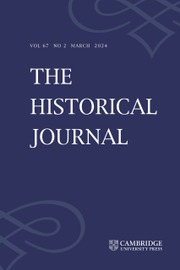No CrossRef data available.
Article contents
BUYING AND BECOMING: NEW WORK ON THE BRITISH MIDDLE CLASSES Gender, civic culture and consumerism: middle-class identity in Britain, 1800–1940. Edited by Alan Kidd and David Nicholls. Manchester: Manchester University Press, 1999. Pp. xi+223. ISBN 0-7190-5675-4. £14.99. The Victorian parlour: a cultural study. By Thad Logan. Cambridge: Cambridge University Press, 2001. Pp. xvii+282. ISBN 0-521-631182-3. £40.00. Shopping for pleasure: women in the making of London's West End. By Erika D. Rappaport. Bognor Regis, UK: J. Wiley for Princeton UP, 2001. Pp. xiii+323. ISBN 0-691-04476-7. £13.95.
Published online by Cambridge University Press: 23 December 2003
Extract
The history of consumption in nineteenth-century Britain has largely been told as the story of the middle classes. Increasingly, as the three books under review demonstrate, the reverse is also true. The middle classes, they argue, derived their identities in significant measure from their consumerist habits rather than their relation to the means of production or the body politic. That was, as one might imagine, especially the case with women. What they bought, how they shopped, where they lived: these things came to define who a person was. How dramatically the literature on the Victorian middle classes has changed is apparent even from this brief description. Most obviously, the research focus has shifted from structures to identities. The old subjects – the professions, the movements (free trade, the franchise, anti-slavery), evangelical religion – are hardly anywhere to be seen in these volumes. Instead, they take up topics more often associated with French history: urban culture, shopping, interior decoration. With this shift in subjects has also come, either implicitly or explicitly, a sense that the defining characteristics of the British middle classes must be sought in the realm of culture, not politics or production.
- Type
- Review Article
- Information
- Copyright
- © 2003 Cambridge University Press




